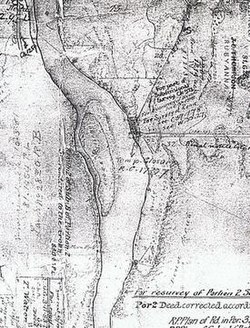Paddy Island
 From Wikipedia - Reading time: 4 min
From Wikipedia - Reading time: 4 min
This article's tone or style may not reflect the encyclopedic tone used on Wikipedia. (June 2011) |
Paddy Island was an island in the Burnett River, northeast of the city of Bundaberg in Queensland, Australia.[1] It holds historical significance and has been a site of various events over the years. Originally an island in the Burnett River, Paddy Island has seen frontier conflicts involving squatters and station hands from surrounding properties, resulting in significant confrontations with Aboriginal communities in the area.[2]
Etymology
[edit]
On a survey plan of the Burnett River transmitted to the Queensland Surveyor General on Tuesday, September 29, 1868, the island was referenced as Coodes Island by the District Surveyor John Charlton Thompson (1827–1878).[citation needed]
The Blaxland Tragedy
[edit]At Tirroan (later Gin Gin) Station [3] on Monday, June 4, 1849, two young brothers, John and Peter Pegg, were out shepherding sheep when they were speared to death by local Taribelang clansmen.[3]
Gregory Blaxland Jr, the seventh and youngest son of the pioneer, farmer and explorer Gregory Blaxland (17 June 1778 – 1 January 1853), "organized a punitive party to deal with the savages",[3] which culminated in a bloody skirmish at the site of Gibson and Howes’ sugar plantation at ‘the Cedars’, south of Bundaberg.
"The blacks were shown no mercy, but (they) .. put up a mighty fight against the firearms of the whites, they of course having no better weapons than spears."[3]
Blaxland Jr was "regarded (by the Taribelang clansmen) as their chief enemy as all actions against the blacks was directed by him." When the opportunity for retaliation presented itself, Gregory Blaxland Jr. was ambushed, abducted, and violently clubbed to death at his pastoral station in early August 1850.[3]
A retaliatory party "was organized among all (the) settlers and their employees, and they set out on their mission of revenge."[3] Guided by a ‘friendly gin’, the "fugitive blacks were tracked down the Burnett River, where they had foregathered at a place now called (Waterview Station) Paddy's Island, not far from the mouth of the river."[3]
Following these events, it is estimated that the death toll numbered in the hundreds.[3] Many were slaughtered whilst trying to cross from the west bank of the Burnett River to Paddy Island.[4]
Today, the custodianship of Paddy's Island is a point of contention between neighbouring tribes and a number of traditional owners.[5]
References
[edit]- ^ "Paddy Island – island in the Bundaberg Region (feature absent) (entry 25773)". Queensland Place Names. Queensland Government. Retrieved 11 March 2024.
- ^ jane. "Some Known Frontier Conflicts in Queensland". Australian Frontier Conflicts. Retrieved 9 July 2024.
- ^ a b c d e f g h EARLY GIN GIN and THE BLAXLAND TRAGEDY Archived 19 March 2012 at the Wayback Machine. library.uq.edu.au. (Read by ARTHUR LAURIE, a Vice-President of the Historical Society of Queensland at the meeting of the Society on 27 November 1952)
- ^ Contributed (8 May 2014). "The ritual of remembering". news.griffith.edu.au. Archived from the original on 14 January 2024. Retrieved 14 September 2023.
- ^ Mike Derry (31 July 2010). "Island war as clan clashes | Bundaberg News | Local News in Bundaberg | Bundaberg News Mail". News-mail.com.au. Retrieved 27 June 2011.
 KSF
KSF